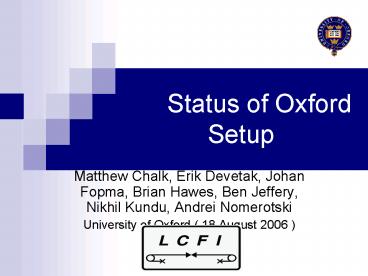Status of Oxford Setup PowerPoint PPT Presentation
1 / 16
Title: Status of Oxford Setup
1
Status of Oxford Setup
- Matthew Chalk, Erik Devetak, Johan Fopma, Brian
Hawes, Ben Jeffery, Nikhil Kundu, Andrei
Nomerotski - University of Oxford ( 18 August 2006 )
2
Oxford Test Setup
- Goals
- Fully test and exercise produced electronics,
should improve understanding, quality and
feedback - Analogue readout of CPC2
- Perform additional CPC2 measurements, build up
CCD expertise - Experiment with power provisions for the clock
driver with real sensor and super-capacitors
3
Oxford Test Setup
Light version of the RAL setup
4
Status
- Minimal configuration is functioning
- Sequencer based on BVM2
- Agilent LV PS
- Oxford Bias PS controlled by BVM1
- Agilent mixed-signal Oscilloscope used as ADC
- LabView code was mostly inspired by RAL examples
- Many thanks to Konstantin for help
- Main parameters
- Sequencer Master Clock 1-10MHz
- Integration time (time between triggers) 0.003 -
0.5 sec - Graph RG, CCD Clock and CCD analogue readout
5
Measurements X-ray signal
- Standard procedure to enhance probability to
have a Fe55 signal need to integrate long time ?
need to operate at low temperature - Our setup is running so far at room temperature ?
accumulate substantial noise from leakage current - Reduced integration time to minimum (3 msec) and
used accumulation feature of the scope
Background noise
Signal (approx. 15mV below the noise )
N.B. Picture taken straight from the oscilloscope
6
Measurements X-ray signal
- RMS of Raw Noise 2-4 mV
- Illuminated CPC2 with Fe55 X-ray source (5.9 keV)
- Signal 15-20 mV ? useful calibration
- 18 mV expected based on expected amplification
etc - 1600 e from Fe55 ? 100 e / mV
- Noise 300 e (to compare to 50-100 e at RAL
ways to go!) - Noise performance is poor as expected at room
temperature and long integration time - Had a setback using the ICS-554 PCI ADC
- Double PCI-PMC carrier does not fit in our PC ? ?
? - Will exchange for a single carrier, here in a
month - Potentially ICS-554 will allow fast readout
(faster than VME), it also has onboard large FPGA
for pre-processing so further speed-up is
possible (for ex setting a threshold and passing
on to the PCI bus only events above the
threshold) - In the meantime tried to detect signal using
scope trace readout to PC but this was too slow - Concentrated on noise measurements
7
Noise Analysis
- Examples on noise graphs
- Different pixels have different offsets
(pedestals) - Software subtracts pedestals so many rows can be
added up (right bottom graph) - Almost no tails in noise distribution ? good fit
by single Gaussian
8
Noise vs Integration Time
- Naively expect that leakage current is main noise
contributor - Ncarriers Tintegration
- Noise sqrt( Tintegration)
- Trigger rate effectively determines integration
time - See some dependence above 100 msec, no dependence
below - It looks that at smaller integration time noise
is not caused by the leakage current ? room for
further improvement?
9
Noise vs Master Clock Frequency
- Higher frequency effectively decreases
integration time so this qualitatively agrees
with previous result
10
Noise analysis
- To explain better what we measure
- Scope traces include 50 consecutive pixels (so
50 rows of CCD) - These 50 rows can be sampled at any location of
CPC2 - Simultaneously 3 CCD columns are measured, see
graph - Amplitude for each pixel is measured at a certain
delay wrt trigger - Can study noise correlations between CCD rows and
columns
11
Noise correlations
- Dnoise standard deviation of amplitude
difference for two channels - If no correlation expect Dnoise to increase by
sqrt(2) wrt noise of single channel - If absolute correlation expect Dnoise to be 0
- If absolute anti-correlation expect Dnoise to be
doubled - Can study
- Column Dnoise expect correlation as readings
are taken simultaneously - Row Dnoise expect less or no correlation as
rows are read out at different time
12
Column Dnoise
- Took data for 12 locations 4x3 columns with
analogue outputs times 3 row regions - Adjacent column Dnoise Aij Ai1j
- Noise 2 mV
- Assuming no correlation between pixels ?
- 2mV/1.4100e/mV 140 e
- Uniform column Dnoise across CCD
13
Column Dnoise
- Correlation of far away columns
- Far away column Dnoise Aij AiNj
- Less correlation with far away columns
14
Row Dnoise
- Adjacent row Dnoise Aij Aij1
15
Row Dnoise
- Far away row Dnoise Aij AijN
- Limited by 50 pixel readings (scope)
- Results suggest anti-correlation
- Need further study a bit controversial
measurement
16
Summary
- Oxford setup is up and running
- So far studied CPC2 noise at room temperature
- Setup was very useful for MB4.3 debugging
hopefully goes to RAL in better shape than
previous versions - Plans
- Lower temperature
- Set up proper ADC readout
- Study signal response ? gain calibration etc
- Set up charge injection mode

